How to Grow Fava Beans: Planting, Care, and Harvest Tips for a Successful Crop
Growing fava beans is like four crops in one: flavorful fresh pods, both fresh and dry beans, and – surprise! – delicious greens to eat fresh or add to cooked dishes.


Growing fava beans (Vicia faba), also known as broad beans, is a remarkably rewarding experience in the vegetable garden. This cool-season legume is a culinary knockout not only for its delicious, large, flat seeds but also for its exceptional soil-building ability through the process of nitrogen fixation. Whether you're planting for fresh pods, dried beans, or as a green manure cover crop, favas bring both flavor and fertility to the garden.
Native to the Mediterranean region – likely the Fertile Crescent or North Africa – fava beans have been cultivated for thousands of years. Today, they remain a staple in many cuisines, particularly throughout the Mediterranean, Middle East, and parts of Asia. In the kitchen, you can enjoy them in many ways: shell them and blanch the fresh beans, use mature beans in stews or soups, or dry and grind them into flour.
Growing beans of any sort is beneficial for both the gardener and the garden. Because favas self-fertilize the soil, produce both fresh and dried food, and are relatively low-maintenance, this type of bean in particular is a wonderful choice for home gardeners starting a vegetable garden highlighting multipurpose, nutritious, and historically rich crops.
Quick Fava Bean Facts
Botanical Name | Vicia faba |
Plant Type | Legume |
Height | 2–4 feet (61–122 cm) |
Spread | 10–12 inches (25–30 cm) |
Light | Partial to full sun, at least 6 hours |
Soil | Well-drained; fertile; pH 6.0–7.5 |
Hardiness | USDA Zones 2–10 (Not in the US? Convert your zone) |
Growing Season | Late winter/early spring |
Time to Harvest | 4–5 months |

Choosing the Right Types of Fava Beans
While gardeners usually encounter the term “broad beans,” agricultural systems categorize distinct types of Vicia faba, each bred for different purposes – fresh eating, drying, animal feed, processing, or soil improvement.
Broad beans: These are the classic fava beans most people are familiar with. They have large seeds which are usually eaten fresh or dried. They are common in Mediterranean and Middle Eastern cooking. Varieties of these broad beans include ‘Aquadulce’, ‘Windsor’, and ‘Sweet Loraine’. Seeds of ‘Windsor’ from Plant Good Seed are available from Walmart.
Horse beans: also known as field beans or faba beans. This is a distinct type of fava bean that is traditionally used for animal feed, as a cover crop, and also in other industrial uses. They are smaller and harder than broad beans and are often grown on a large scale for use as livestock feed and for commercial flours and other food ingredients. With a stronger flavor, horse beans are not typically used in fresh applications.
Vicci beans: Sometimes called “tick beans,” their size falls between broad and horse beans. Common in Europe, Asia, and Africa, vicci beans are used for both human and animal consumption and are often dried or processed.
Sign up for the Gardening Know How newsletter today and receive a free copy of our e-book "How to Grow Delicious Tomatoes".
Planting Fava Beans
Fava beans are most often planted as seeds directly into the garden soil. Their large seeds make planting them a cinch as they are easy to handle and space properly. Favas germinate well in cool soils so you can get out in the garden quite early to begin your crop.
While it is possible to start fava beans indoors in late winter and transplant seedlings outside when the ground is ready, their roots are sensitive to disturbance. Transplanting can set them back or cause weak growth. If you are in a region with a very short season, be sure to start seeds indoors in very deep containers that would allow the beans’ roots to be minimally disturbed when transplanted in the ground in spring.
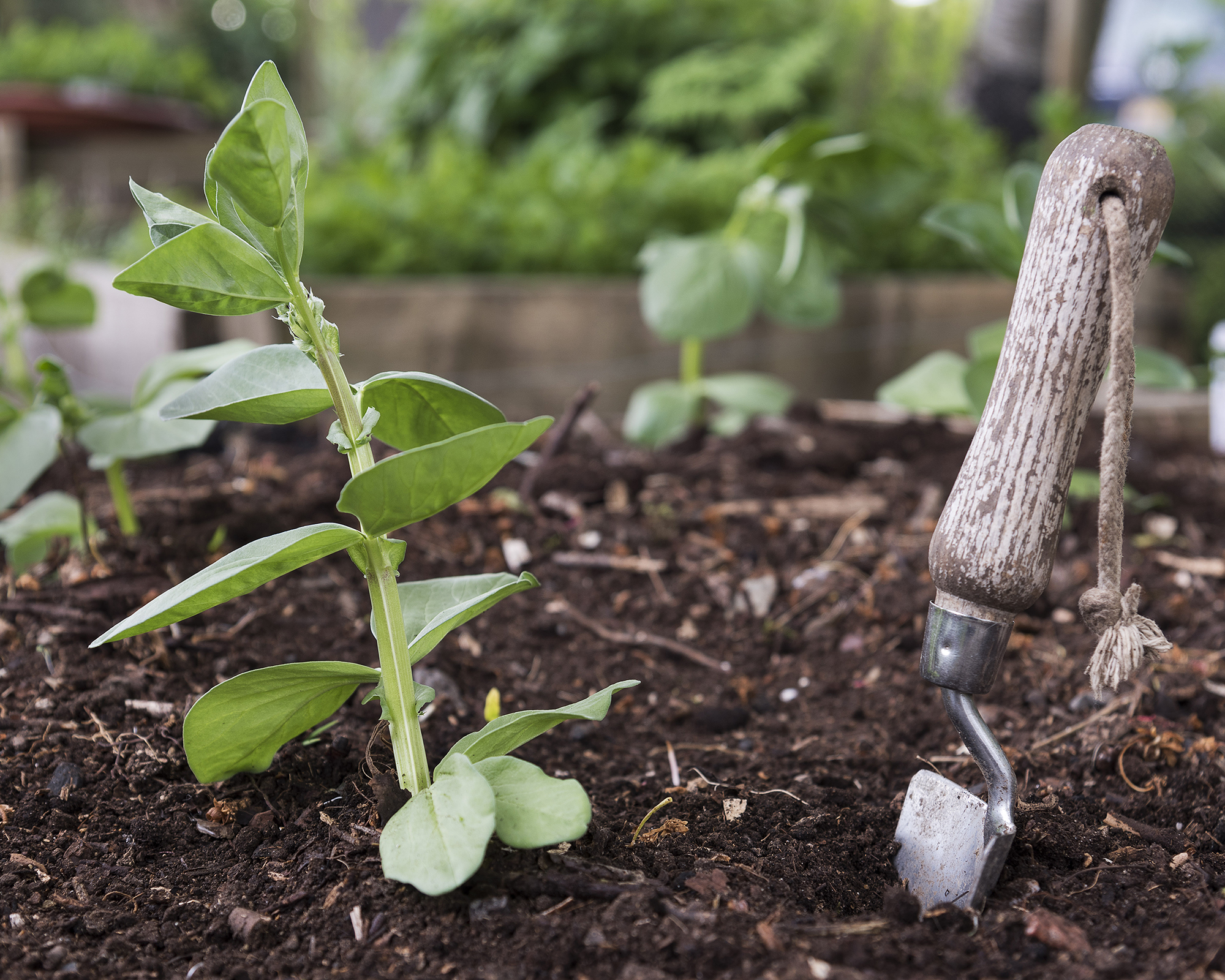
When to Plant Fava Beans
Fava beans require 4–5 months from planting to harvest. They are a cool-season crop, so when to plant them depends on your climate. The goal is to grow them in temperatures of 40–75°F (4–24°C) to avoid heat during flowering.
In cooler climates, USDA Zones 3–10, plant in spring as soon as the soil can be worked – about 2–4 weeks before your last spring frost. Favas tolerate light frosts and even brief dips into the upper 20s°F (-3–1°C).
In areas with mild or frost-free winters (West Coast, southern states, USDA Zones 8–11), plant fall through early winter. They will overwinter easily and produce a spring crop. This is how they’re grown in climates where they are native.
Cool soil is preferable – prolonged warm temperatures will reduce your yield of pods.
Best Soil for Fava Beans
Fava beans are tolerant of a variety of soil types but do best in well-draining heavy loam or clay-loam soil. Good drainage is essential because fava beans are prone to root rot if spending too much time in waterlogged soil. Keep soil moist but not saturated.
Favas do not need rich, heavily fertilized soil as they are able to “fix” or create their own nitrogen. In fact, too much nitrogen may even lead to too much leafy growth at the expense of the crop of pods themselves.
As for soil pH, favas prefer a slightly acidic to neutral soil, staying within 6.0–7.5. Use a testing kit, like the MySoil Test Kit, available on Amazon, to check whether any amendments are required to make soil more acidic.
Fava Bean Light Requirements
Find a space in your garden that receives full sun for at least 6 hours each day. This will allow the plant to be strong and healthy, better able to resist diseases and pests, and produce as many flowers and pods as it can. It is possible for favas to grow in partial sun (4–6 hours), but their growth, performance, and pod set will be impacted, taking longer to mature and producing fewer pods.
For gardens in hot climates (USDA Zones 9 and above), where cool spring weather quickly warms, full sun in the morning is ideal, with light afternoon shade helping the plants to avoid heat stress.
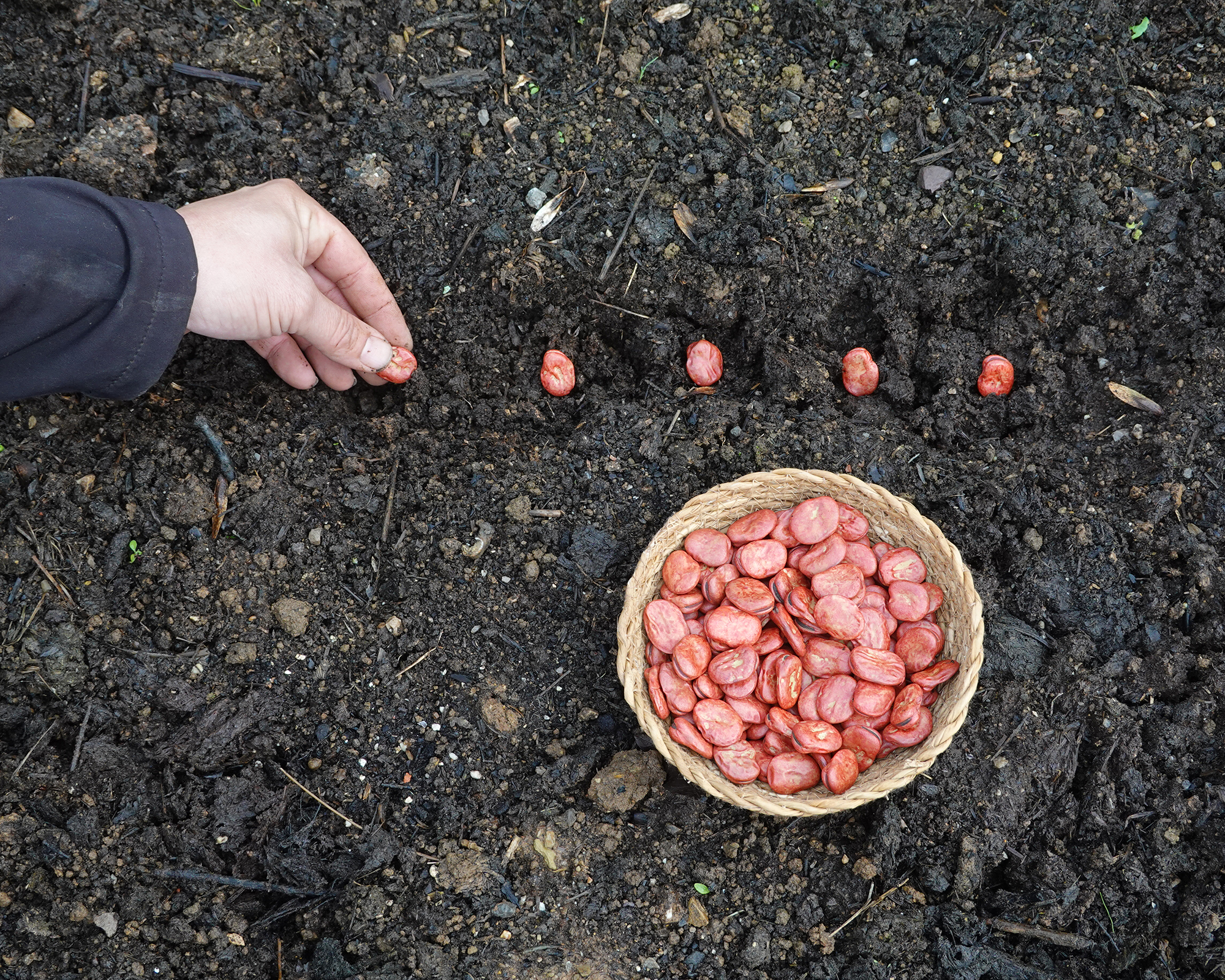
How to Plant Fava Beans – Step by Step
With your planting time and spot chosen, use these simple steps to plant fava beans successfully and with minimal fuss:
- Prepare your bed. Remove weeds, loosen the top 6–8 inches (15–20 cm), and work in a few inches of compost. As fava beans fix their own nitrogen, there is no need to add a high-nitrogen fertilizer.
- Sow seeds at the correct depth. Plant seeds 1–2 inches (2.5–5 cm) deep with the “eye” of the seed facing downward. Germination may be slow in cool soils (7–21 days).
- Space properly. Space fava bean seeds 3–6 inches (7–15 cm) apart. Rows should be 18–36 inches (45–90 cm) apart.
- Water to establish. Keep soil evenly moist until seedlings are well established; avoid waterlogging.
Fava Bean Care
Once germinated, fava beans will benefit from your routine maintenance. Your efforts will be rewarded with a bountiful crop.
How Often to Water Fava Beans
As mentioned, fava beans prefer steady levels of moisture but do not like to be soggy. They benefit most from consistent watering of about 1 inch (2.5 cm) of water per week. This consistency matters most in three stages of growth:
- During germination and seedling development, to support growing roots.
- During flowering, to reduce drought stress that causes flowers to drop.
- During “pod fill,” or when the seeds are developing, as not enough moisture can result in small or misshapen beans.
When watering, aim the water at the base of the plant to avoid wetting the leaves. Using drip irrigation, a soaker hose or a long-handled nozzle such as this RESTMO 36-in. watering wand available from Amazon can help direct the irrigation water.
Fertilizing Fava Beans
As mentioned above, fava beans fix much of their own nitrogen, so the goal with fertilizing favas is to support them – not push them. More nitrogen than necessary will produce more leaves than pods and result in a low-yielding crop. At most, you would work some compost into the planting bed, mainly to improve the soil’s structure and help retain moisture.
During the growing season, your crop will only need additional fertilizer if your soil was nutrient-poor to start, or if your plants are looking pale or stunted. If you feel additional fertilizer is necessary, use a low-nitrogen organic fertilizer (bone meal, kelp meal, or a bloom formula) and apply it lightly. Vigoro bone meal is available at The Home Depot.
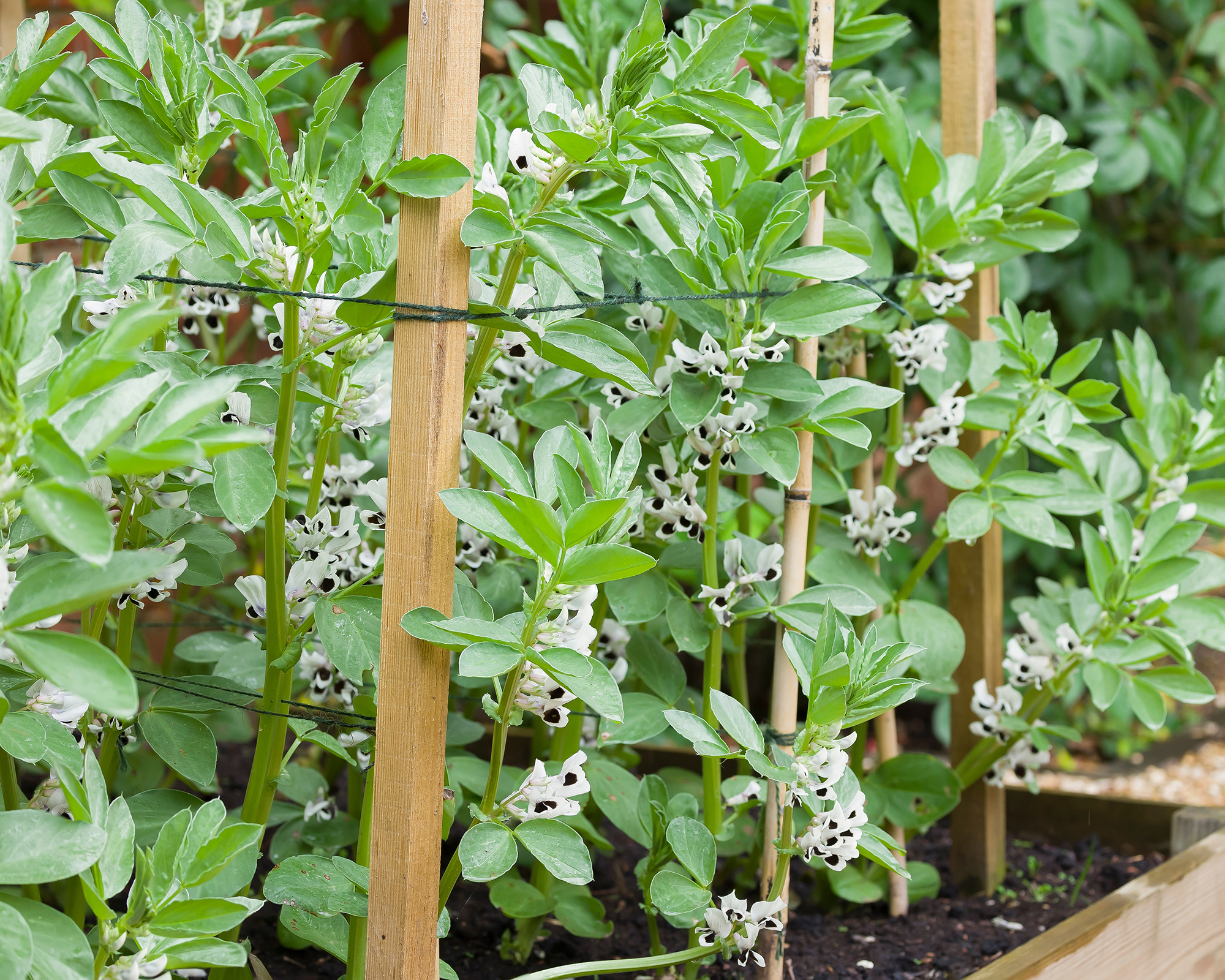
Supporting Fava Beans
Fava bean plants are typically sturdy and don’t usually need support to keep them upright. However, your plants may benefit from light support measures if:
- Plants grow 3–5 feet (1–1.5 m)
- They produce heavy pods
- They’re in a windy area
- Rows are spaced widely and plants can’t support each other
If you find supports are needed, simple staking methods should suffice. For instance, place stakes at the ends of the rows and run twine around and outside the plants at two different heights to hold the plants upright.
Mulching Fava Beans
Mulch is very much advised for fava bean crops. A 2–4 inch (5–10 cm) layer of straw, shredded leaves, or composted bark will help retain moisture, suppress weeds, and moderate soil temperatures. When applying mulch, take care to keep it out of contact with the plant’s base to avoid rot and damage.
Pruning & Pinching Plants
Fava beans don’t generally need regular pruning or pinching. You may find that a light trimming can be helpful in certain situations. A pinch of the growing tips can help side branching, for instance. Trimming the upper stems of taller varieties can help stop the plants from flopping, as well. And of course, removing damaged, yellowing, or crowded leaves can improve air circulation and help prevent fungal problems.
Wait until your fava bean plant is at least 8 inches (20 cm) before pinching or trimming. Also, avoid heavy pruning during flowering or pod development, as this can reduce yield.
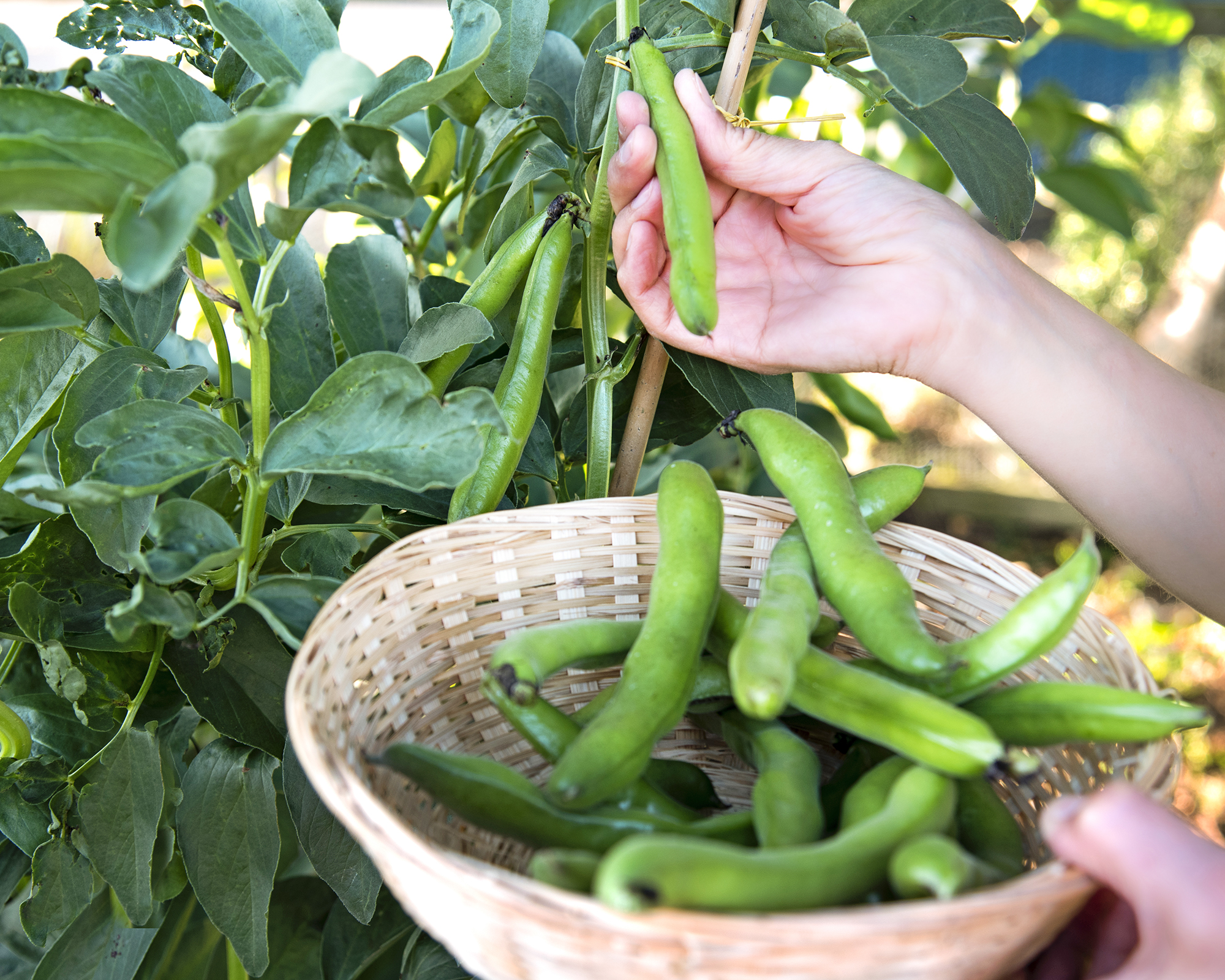
Harvesting Fava Beans
Harvesting fava beans depends on whether you want fresh pods, shelling beans, or dried beans. Timing and method vary slightly for each.
If you wish to eat your favas as fresh beans in their pods, harvest when the pods are young, tender, and bright green. They are usually ready for harvest 2–3 months after planting, before the seeds fully swell. Pods mature quickly, so check your plants every few days for still-green pods. Young pods can be eaten whole after blanching.
For fava beans that you wish to use as seeds from mature pods, let the pods grow until the seeds inside are fully developed but still soft. The pods are usually thick and slightly firm. Just pick the pods from the plant, shell them by hand, and blanch before eating or cooking.
Favas can also be harvested as dry beans that can then be stored. Let the pods fully mature and dry out on the plant. They’ll be ready for harvest when they turn brown and brittle. This usually takes 3–4 months, depending on climate.
But pods aren’t all the wonderful fava bean has to offer. Most growers of fava beans probably never even thought about eating the tops of broad bean plants, but yes, broad bean leaves are, indeed, edible. Not only does the plant provide nutritious beans and amend the soil with nitrogen, but the fava greens are edible and absolutely delicious, too.
The leaves are best when harvested young and tender, where the new leaves and blossoms are emerging at the top of the plant. Snip off the top 4–5 inches (10–12.5 cm) of the plant for use in salads, much like young spinach leaves. If you wish to cook the fava greens, use the lower leaves and cook them as you would other greens.
The tender young leaves from the top of the plant are sweet with a slight buttery, earthy taste. They can be eaten raw or cooked, and are excellent when made into a fava green pesto. The older greens can be sautéed or wilted as you would spinach and used exactly the same way in egg dishes, kinds of pasta, or just as a side dish.
Fava Bean Care Calendar
| Header Cell - Column 0 | Spring | Summer | Fall | Winter |
|---|---|---|---|---|
Start Seeds Indoors | ✓ (cool zones) | Row 0 - Cell 2 | ✓ (mild/warm zones) | Row 0 - Cell 4 |
Sow Seeds Direct | ✓ | Row 1 - Cell 2 | ✓ (mild/warm zones) | ✓ (mild climates) |
Transplant | ✓ | Row 2 - Cell 2 | ✓ (mild/warm zones) | Row 2 - Cell 4 |
Fertilize | ✓ | Row 3 - Cell 2 | ✓ | Row 3 - Cell 4 |
Mulch | ✓ | Row 4 - Cell 2 | ✓ | ✓ |
Harvest | ✓ | Row 5 - Cell 2 | ✓ | Row 5 - Cell 4 |
Preparing and Storing Fava Beans
For favas to be used other than in their fresh pod state, you’ll need to shell the beans from their pods. For fresh beans, remove beans from pods as soon as possible after harvest to prevent them from becoming tough. For beans meant for drying, shell them once the pods are fully brown and brittle. This reduces the risk of mold or pest damage during storage.
Prepare your dry beans for long-term storage by spreading the beans in a single layer on a tray or a screen that is placed in a dry, well-ventilated area away from direct sunlight. Let them air-dry until they are hard and break easily. You can also use a dehydrator set to a low temperature.
Once completely dry, store the beans in airtight containers such as glass jars, food-safe buckets, or vacuum-sealed bags. Keep them in a cool, dark, dry place (ideally 50–60°F/10–16°C). Stored properly, dried beans can last 1–2 years.
It’s also possible to store fresh beans by freezing. Once they are shelled, blanch them in boiling water for 2–3 minutes, then cool in ice water. Let the beans dry, then freeze in airtight containers or freezer bags. This method preserves their flavor for up to a year.
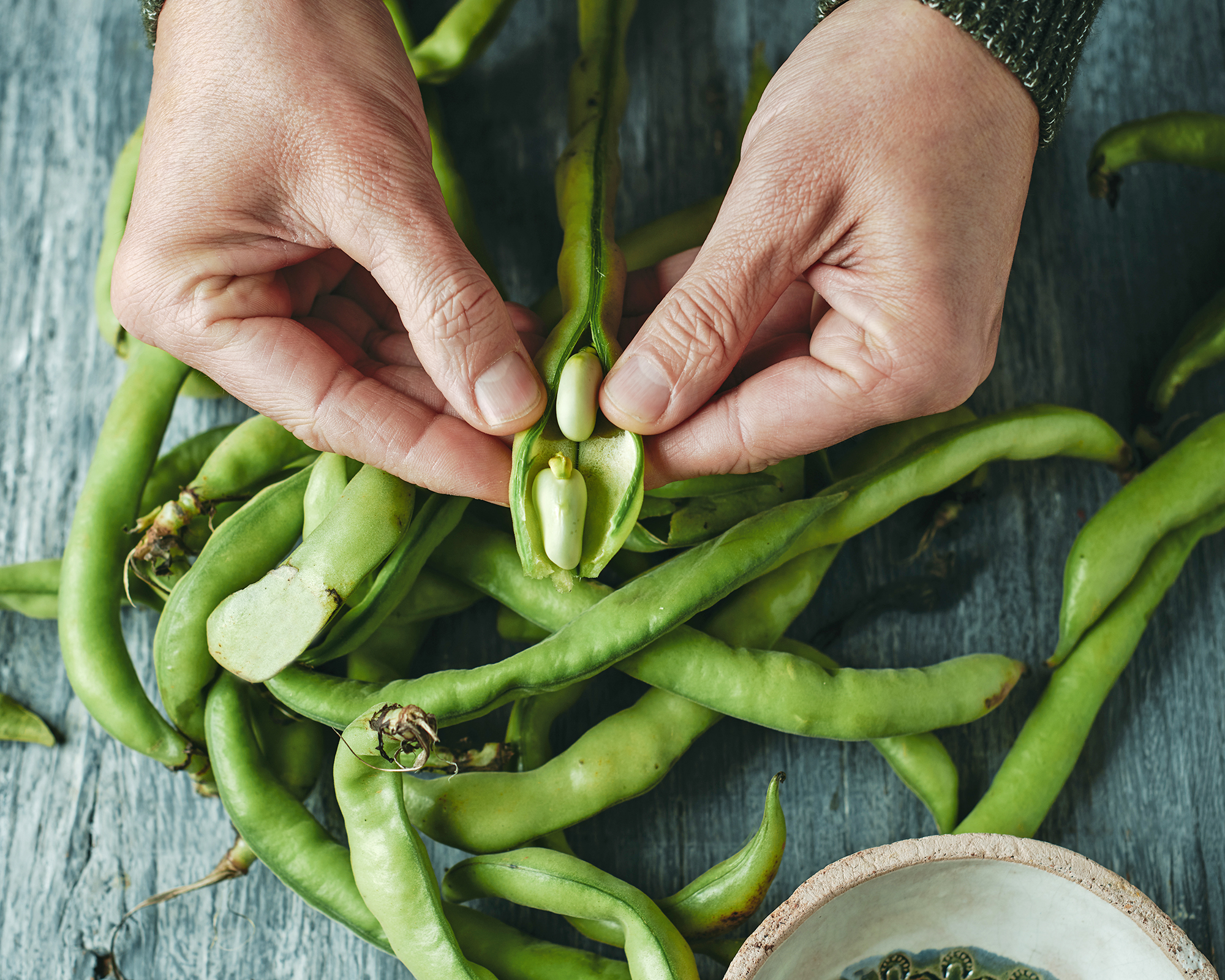
Propagating Fava Beans
Use your dry-harvested fava beans both in the kitchen and in next year’s garden. That’s right, you can save a portion of your fava bean harvest from one season to grow your next season’s crop. Using your own harvest as seed means you’ll be able to easily and affordably cultivate the bean varieties you enjoy most.
When saving bean seeds for next season, let your pods fully dry on the plant, then shell and air-dry the seeds in a well-ventilated area. Save only the seeds that are not shriveled or damaged in any way. Store them in airtight containers in a cool (50–60°F/10–16°C), dry, and dark location. Fava beans generally remain viable for 1–2 years if stored well. Older seeds benefit from pre-soaking for 12–24 hours before planting to improve germination.
Fava Bean Problems
Fava beans are relatively hardy, but several problems can affect their growth. Aphids are its most common pest, feeding on leaves and transmitting viral diseases, especially during cool, damp weather. Slugs and snails are another scourge and can damage seedlings as the crop begins to grow. And sometimes birds start to harvest the young pods before you get the chance.
Favas are also impacted by fungal diseases. Chocolate spot (Botrytis fabae) produces small brown spots on leaves, stems, and pods, and is worsened by wet, humid conditions. Rust on beans appears as orange-brown pustules on leaves and can occur in humid conditions. Both diseases reduce photosynthesis and vigor. And root rot, caused by a variety of different soil-borne fungi, can cause wilting, stunted growth, browning, and eventual plant decline and death.
Environmental stresses cause problems, too. For instance, heat during flowering can cause flowers to drop and reduce pod set. Crop rotation and proper spacing, along with monitoring for pests, are keys to minimizing these problems.
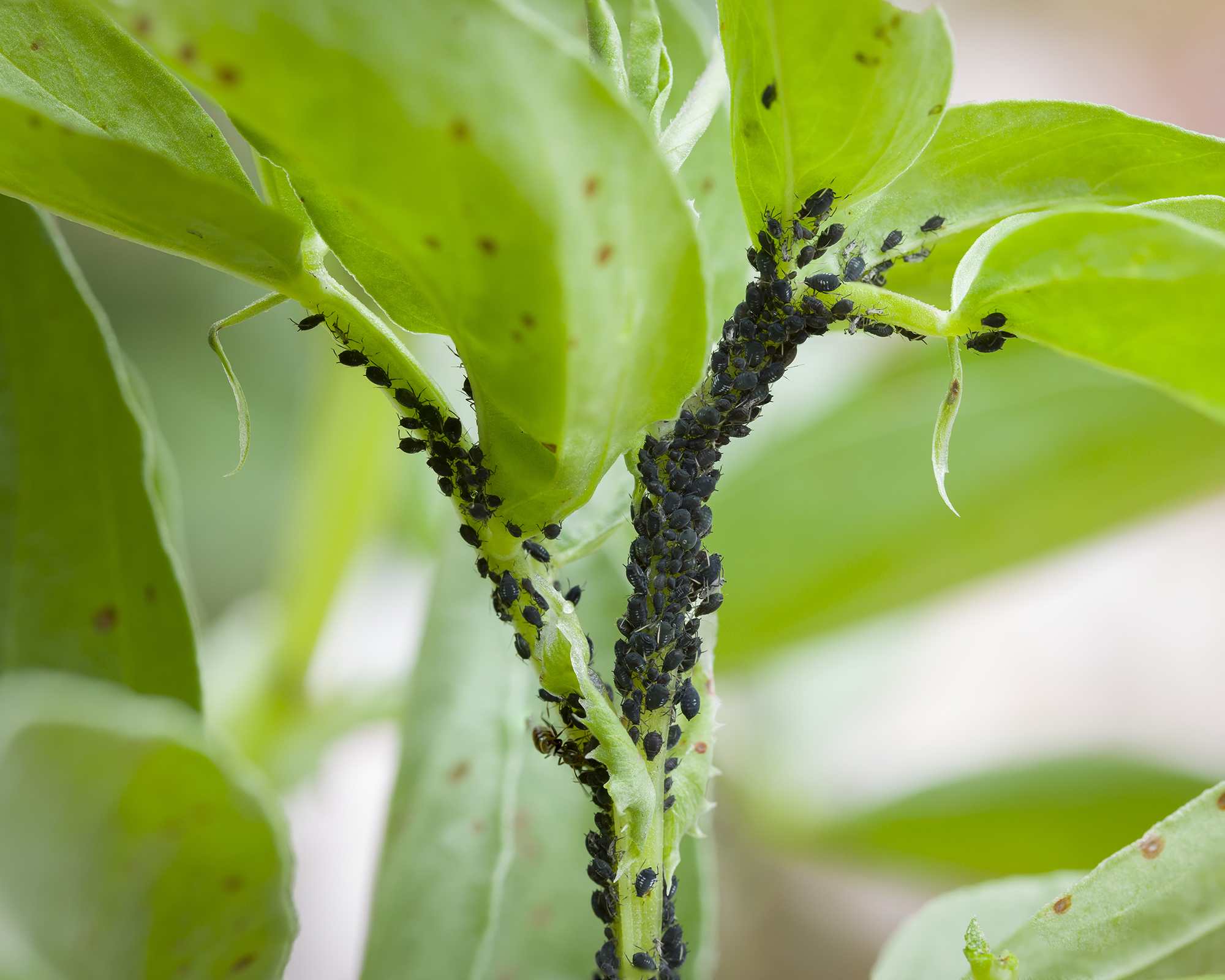
Growing Fava Beans in Containers
Fava beans are not confined to in-ground garden beds. Properly situated, they can be a great addition to a small patio or container vegetable garden.
Choose a large container at least 12–16 inches (30–40 cm) deep to accommodate the plant’s long taproots. The container must have good drainage (i.e. some sort of hole or opening). Fill it with a loamy, well-draining potting mix enriched with compost. Sow 2–3 seeds 1–2 inches (2.5–5 cm) deep, thinning seedlings to just 1–2 plants per pot as they germinate and grow. Keep the soil consistently moist but not waterlogged, and place the container in full sun. Tall varieties may need light staking, especially since they have more biomass above soil level.
Growing Fava Beans Indoors
With sufficient light, proper containers, and careful watering, fava beans can thrive indoors, producing edible pods even in small spaces.
Follow the same procedure as for growing in containers, paying particular attention to light levels. A south-facing window may not provide sufficient light, especially if grown indoors during fall and winter. Grow lights used for 12–16 hours each day can give your favas the light they need. A full-spectrum LED grow light, such as this one from Lowe’s, can bathe your favas in enough light for good crop production.
Another consideration is pollination. Outdoors, favas and other beans rely on bumblebees and other insects. While it’s possible for them to self-pollinate, pod production will be reduced. When growing favas indoors, you’ll need to pollinate their flowers by hand. Do this by using a brush to transfer pollen from one flower to another.
Fava Beans as a Cover Crop
Once you have harvested the growing fava beans, and if you choose not to eat the green leaves, the plant makes an excellent cover crop. The bushy greens aid in erosion prevention and protect the topsoil from rain impaction and wind. Fava beans, like all legume plants, have nitrogen-rich nodules on their roots and contribute to replenishing nitrogen to the soil for future crops. This reduces or eliminates the need for synthetic fertilizers.
Favas also produce a dense canopy, which shades the soil, suppresses weeds, and protects against erosion from wind and rain. Their deep, fibrous roots help break up compacted soil, improving drainage and aeration, while also contributing organic matter when the plants are incorporated into the soil. They grow well in cool seasons, making them ideal for fall or winter cover cropping in many climates. Using this versatile bean as a cover crop is a sustainable strategy that enhances soil fertility, prevents erosion, and promotes a healthy garden ecosystem.

Companion Planting Fava Beans
Fava beans can benefit from and be a benefit to other plants by thoughtful companion planting.
Plants in the cabbage family (broccoli, cabbage, kale, cauliflower, etc.) benefit from fava beans’ nitrogen fixation, while quick-growing leafy greens thrive shade cast by the taller plants. Carrots, beets, and other root vegetables grow well alongside favas without competing for above-ground space. Strawberries, which are nutrient-hungry plants, thrive in soils enriched by favas.
Not all plants are friends with favas. For example, onions and garlic may release compounds that can inhibit fava bean growth. Other legumes, too, should be avoided to reduce diseases and pests.
Frequently Asked Questions
What is the "eye" of a fava bean?
The "eye" of a fava bean refers to the small, slightly indented spot on the seed – the hilum – where it was connected to the pod. It is similar to the "eye" of a potato in that it marks the connection to the parent plant. When planting fava beans, the eye usually faces downward in the soil, though they can germinate in any position. Planting this way may help the root emerge more easily. Fava seeds are so robust, however, that they will usually sprout successfully regardless of orientation.
What is a legume inoculant?
A legume inoculant is a mix of beneficial bacteria (Rhizobium) that helps fava beans fix nitrogen from the air. Applying it to seeds or soil encourages root nodules, improving plant growth, yield and soil fertility. It's especially useful in soils where favas haven't been grown before or in low-nitrogen soils.
Fava Bean Growing Essentials
- Start with high-quality seeds – Seeds of ‘Windsor’ from Plant Good Seed are available from Walmart.
- Test your soil with the MySoil Test Kit, available on Amazon to be sure its pH is suitable for growing fava beans.
- Direct watering to the base of your fava bean plants is easy with the RESTMO 36-in. watering wand available from Amazon.
- Fertilize without adding too much nitrogen with this Vigoro bone meal available at The Home Depot.
- Growing fava beans indoors is possible with supplemental lighting from this full-spectrum LED grow light available from Lowe’s.

Ellen Wells is a horticultural communications consultant with 30 years of experience writing about all aspects of the gardening world.
She has worked for many of horticulture’s biggest brand names, writing blog posts, articles, press releases, and design and instructional pieces. Her previous roles include Senior Editor and Editor-at-Large for Ball Publishing.
Ellen is based in New England where she gardens in Zone 7a. She loves tending to flower-filled containers on the patio and puttering around her vegetable garden.
- Mary Ellen EllisWriter
- Amy GrantWriter